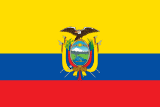Gender Quotas Database

Ecuador
South America
Single / Lower House
Asamblea Nacional / National Assembly
| Total seats | 151 |
| Total women | 68 |
| Percentage of women | 45% |
| Gender Quota target | 50% |
| Election year | 2025 |
| Electoral system | List PR |
| Quota type | Legislated Candidate Quotas |
| Election details | IDEA Voter Turnout - IPU Parline |
| Legal source | Details | |
|---|---|---|
| Quota type: Legislated Candidate Quotas | Constitution |
For multi-person elections, the law shall establish an electoral system in line with the principles of proportionality, equality of vote, equity, parity and rotation of power between women and men and shall determine the voting precincts inside and outside the country. (Article 116) |
| Electoral law |
The candidates must be selected through primary elections or internal democratic electoral processes, which guarantee equal participation between men and women applying the principles of parity, alternation, sequentially among members, adherents, militants, sympathizers or independent people; (Article 94) The representatives to the National Assembly, representatives to the Andean Parliament, regional councillors, district and municipal councillors and members of rural parish councils will be elected by voting for the respective lists of the political organizations, or alliances of their preference established through internal democratic processes or primary elections, which will strictly maintain equity, parity, alternation and sequentially between men and women or vice versa and will be presented in compliance with the principles and rules of parity and inclusion of young people defined in this law. (Article 160) |
|
| Legal sanctions for non-compliance | Electoral law |
The National Electoral Council and the Provincial Electoral Boards may not deny the registration of candidates, except in the following cases: 2. That the lists and candidates do not strictly respect the principles and rules of parity, alternation and sequentially between women and men, as well as the inclusion of young people, established therein; and, (Article 105) |
| Rank order/placement rules | Electoral law |
For the application of this article and as affirmative action, at least fifty percent of all lists of multi-person and single-person candidates for primary elections or internal democratic electoral processes will be headed by women. (Article 94) Multi-person candidacies will be presented in complete lists with main candidates and their respective alternates. The lists will be made up equally with a sequence of woman - man or man - woman until the total number of main and substitute candidates is completed. ... 1. In the case of lists presented by the political organization for the election of national and parliamentary assembly members or Andean parliamentarians, at least one of these lists will be headed by women. ... (Article 99) The representatives to the National Assembly, representatives to the Andean Parliament, regional councillors, district and municipal councillors and members of rural parish councils will be elected by voting for the respective lists of the political organizations, or alliances of their preference established through internal democratic processes or primary elections, which will strictly maintain equity, parity, alternation and sequentially between men and women or vice versa and will be presented in compliance with the principles and rules of parity and inclusion of young people defined in this law. (Article 160) … In the event of a tie between candidates of different sex, the candidate will have preference in the award in application of affirmative action measures and the principles of equity and parity recognized by the Constitution and the Law. (Article 165) |
| Is the provision of direct public funding to political parties related to gender equality among candidates? | No |
There is a general provision for parity, but not an specific rule regarding direct public funding tied to gender equality. See more in International IDEA's Political Finance database |
| Are there provisions for other financial advantages to encourage gender equality in political parties? | No | See more in International IDEA's Political Finance database |
Quota at the Sub-National Level
| Quota type | Legislated Candidate Quotas |
| Gender Quota target | 50% |
| Legal source | Details | |
|---|---|---|
| Quota type: Legislated Candidate Quotas | Constitution |
For multi-person elections, the law shall establish an electoral system in line with the principles of proportionality, equality of vote, equity, parity and rotation of power between women and men and shall determine the voting precincts inside and outside the country. (Article 116) |
| Electoral law |
The representatives to the National Assembly, representatives to the Andean Parliament, regional councillors, district and municipal councillors and members of rural parish councils will be elected by voting for the respective lists of the political organizations, or alliances of their preference established through internal democratic processes or primary elections, which will strictly maintain equity, parity, alternation and sequentially between men and women or vice versa and will be presented in compliance with the principles and rules of parity and inclusion of young people defined in this law. (Article 160) |
|
| Legal sanctions for non-compliance | Electoral law |
The National Electoral Council and the Provincial Electoral Boards may not deny the registration of candidates, except in the following cases: 2. That the lists and candidates do not strictly respect the principles and rules of parity, alternation and sequentially between women and men, as well as the inclusion of young people, established therein; and, (Article 105) |
| Rank order/placement rules | Electoral law |
Multi-person candidacies will be presented in complete lists with main candidates and their respective alternates. The lists will be made up equally with a sequence of woman - man or man - woman until the total number of main and substitute candidates is completed. ... 1. In the case of lists presented by the political organization for the election of national and parliamentary assembly members or Andean parliamentarians, at least one of these lists will be headed by women. ... (Article 99) The representatives to the National Assembly, representatives to the Andean Parliament, regional councillors, district and municipal councillors and members of rural parish councils will be elected by voting for the respective lists of the political organizations, or alliances of their preference established through internal democratic processes or primary elections, which will strictly maintain equity, parity, alternation and sequentially between men and women or vice versa and will be presented in compliance with the principles and rules of parity and inclusion of young people defined in this law. (Article 160) |
Voluntary Political Party Quotas*
| Party | Official Name | Details, Quota provisions |
|---|---|---|
| No data available. | ||
* Only political parties represented in parliament are included. When a country has legislated quotas in place, only political parties that have voluntary quotas that exceed the percentage/number of the national quota legislation are presented in this table.
Additional information
According to the 2009/2012 Electoral Law, the candidates of the political parties for the elections for the National Assembly, the Andean Parliament, the Latin-American parliament, and the regional and municipal councils will be chosen through internal primary elections in which the principles of parity and alternation will be applied (Article 160). Furthermore, political parties should respect these principles in internal elections for the nomination of candidates and in their internal structures and political functions (Articles 94 and 343).
In 1997 a 20 per cent quota was introduced for the Chamber of Deputies, and the percentage was set to increase by 5 per cent for each election cycle until parity was reached (Cañete 2008). In the 2002 national elections, some parties did not comply with the new electoral law, mostly regarding the rank-order rules. The Supreme Electoral Tribunal did not use its mandate to reject the registration of these lists (Cañete 2008). This system was overturned by the new Constitution and the laws now in effect.
Sources
Legal Sources:
Other Sources:
- Parliament of Ecuador - Link
- Electoral Commission - Link
- International Foundation for Electoral Systems - Link
- Cañete, M. F., ‘Las mujeres y el déficit de democracia en los partidos y los movimientos políticos independientes’ [Women and the democratic deficit in parties and independent political movements’], in B. Llanos and K. Sample (eds), Del dicho al hecho: manual de buenas practicas para la participación de mujeres en los partidos políticos latinoamericanos [From words to action: best practices for women’s participation in Latin American political parties] (Stockholm: International IDEA, 2008)
- Llanos, B (2019): “Surcando olas y contra-olas. Una mirada paritaria a los derechos políticos de las mujeres en América Latina”. Atenea, International IDEA, ONU Mujeres, UNDP.
Additional reading
- See the latest updates on Ecuador on iKNOW Politics
- Gender Equality Observatory for Latin America and the Caribbean: Ecuador (Official Website)
- Peralta Zambrano, A (2005): "Ley de cuotas y participación política de las mujeres en el Ecuador" Revista IIDH Vol.42. Pp: 377-405.
- Htun, Mala N. 2002. ‘Mujeres y poder político en Latinoamérica,’ in International IDEA, Mujeres en el Parlamento. Más allá de los números, Stockholm: International IDEA, pp. 19-44.
- Htun, Mala N. and Jones, M. P. 2002. ‘Engendering the Right to Participate in Decision-Making: Electoral Quotas and Women's Leadership in Latin America.’ Nikki Craske and Maxine Molyneux(ed.) Gender and the Politics of Rights and Democracy in Latin America. New York: Palgrave. pp. 32-56.
- Pacari, N. 2002. ‘La Participación Política de la Mujer Indígena en El Congreso Ecuatoriano’, in M. Méndez-Montalvo and J. Ballington (eds) Mujeres en el Parlamento – Más alla de los números, Stockholm: International IDEA, pp. 45–62.
- Peschard, J. 2002. ‘El sistema de cuotas en América Latina. Panorama general,’ in International IDEA. Mujeres en elParlamento. Más allá de los números, Stockholm: International IDEA, pp. 173-186.
- Jimenez Polanco, J. 2001. ‘La représentation politique des femmes en Amérique Latine: une analyse comparée’ (Women's political representation in Latin America: a comparative analysis). Bérengère Marques-Pereira and Patricio Nolasco (ed.) La représentation politique des femmes en Amérique Latine(Women's political representation in Latin America). Brussels: L'Harmattan. pp. 27-81.
- Women's Leadership Conference of the Americas. 2001. Women and Power in the Americas: A Report Card. Washington: Women's Leadership Conference of the Americas.
- Htun, Mala N. 1998. Women's Political Participation, Representation and Leadership in Latin America. Issue Brief, Women's Leadership Conference of the Americas.
- León, M. 1998. ‘Ecuador: La incidencia de la agenda internacional en la participación femenina y en las políticas para la equidad de género en el Ecuador.’ Silvia Vega Ugalde (ed.). Acceso de las mujeres a la toma de decisiones en los países andinos. Quito: Coalición Política de Mujeres Andinas. pp. 109-145
- Gutierrez, E. 1997. ‘Women-Latam: Andean Women Flex Their Political Muscle.’ Interpress Service, September 23.
- Inter-Parliamentary Union. 1997a. Men and Women in Politics: Democracy Still in the Making, A World Comparative Study. Geneva: Inter-Parliamentary Union.
- Merizalde, B & Soledad, M. 1997. La participación de la mujer en la política ecuatoriana(The participation of women in Ecuadoran politics). Quito: Editorial Universitaria.
- Ecuador Parliament website, http://www.asambleanacional.gob.ec/es
Explore more resources: Americas | Global
Know about useful additional reading for Ecuador? Tell us!
Submit feedback
Submit questions or comments about the Data or Tool
How did you find out about this? What do you like about it? What did you expect but did not find in using the Data or Tool?
To see how we handle your personal data, please read our Privacy Policy.
